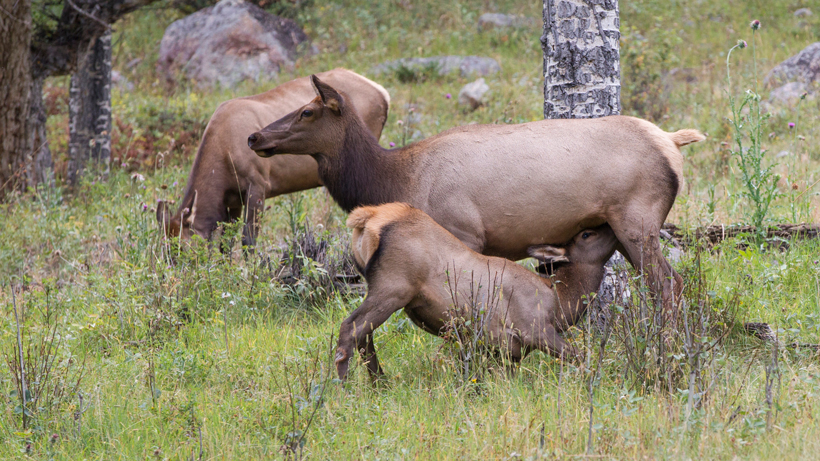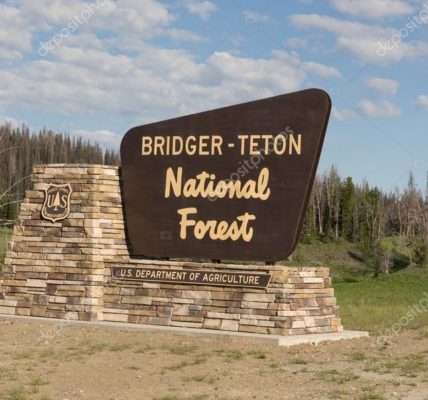
By Mike Koshmrl, WyoFile.com
Millions of visitors flock to Yellowstone National Park each summer to gawk at geysers, waterfalls and charismatic megafauna like elk.
Bugling bulls and their harems of cows are a major part of the draw to the iconic western park that’s been protected for the past 150 years. Down the Yellowstone plateau dozens of miles to the east, however, the landscape is privately owned, increasingly valuable and changing rapidly. And the same elk spend much of their lives there.
“These herds are important not only to the folks that live in Cody and who own property here, but they’re, what I would consider, a worldwide resource because of the use in Yellowstone,” said Tony Mong, a wildlife biologist with the Wyoming Game and Fish Department who manages the Cody and Clarks Fork elk herds.
Private landowners, he said, represent a “piece of the puzzle” that will ensure Yellowstone elk thrive for generations to come.
While it’s no secret elk are high-country critters that migrate to ranchlands, foothills and river valleys where humans tend to live, their dependence on the private ground has only recently been scientifically quantified. The data, curated by former University of California-Berkeley postdoc Laura Gigliotti, expose a vulnerability: More than 36% of all the mapped elk habitat in the Greater Yellowstone Ecosystem lacks even basic zoning. It’s land that’s ripe for real estate development in an era of sky-high interest in owning a piece of the West.
“We only focus on elk in the GYE, but this is something that’s happening throughout the world,” Gigliotti said. “Thinking about conservation that spans these different [land ownerships] is relevant beyond just this one particular system.”
Gigliotti’s research took stock of all 26 elk herds that fan out from the Greater Yellowstone Ecosystem’s interior toward its fringes come winter. It involved mapping the movements of 1,088 GPS-collared elk into seasonal ranges and cross-referencing those movements with databases showing land ownership, protected areas and the numbers of properties. The study, recently published in the journal of Biological Conservation, also quantifies humankind’s other influences on the seasonal ranges of each individual elk herd, like fence density, energy-related infrastructure and cattle.
Gigliotti’s high-level analysis was overdue, said UC-Berkeley wildlife policy professor Arthur Middleton, who advised the research and has spent a decade studying migratory Yellowstone ecosystem elk. He sees Gigliotti’s work as foundational, the type of “back to the basics” research that provides context and direction to more targeted studies like how elk are affected by development. (Disclosure: Middleton is married to WyoFile board member Anna Sale.)
“In a sense, it’s the paper we should have done 10 years ago that would inform where we went next,” Middleton said. “It took me a while to realize we had skipped the meat and potatoes.”
That research reveals which elk herds are most vulnerable to development, where and at what time of year.
In the Bighorn Basin, for example, just 25% of the Clarks Fork herd winter range and 18% of Cody herd winter range falls on lands where there’s some type of zoning. For now, much of that habitat sits on large ranches sprawled out at the base of the Absarokas. It’s still open country; there’s just one building per square mile on the Clarks Fork herd’s winter range and 1.9 buildings per square mile where the Cody herd dwells. But that could change as development pressure increases.
Other Wyoming elk herds are already more pressed by people.
Where wapiti crowd on feedgrounds in the southern Greater Yellowstone Ecosystem, the Fall Creek herd navigates a winter landscape where there are 20 buildings per square mile. Just north of there where the Jackson herd winters, building density exceeds 12.5 per square mile.
Both those herds, notably, are faring well — and subdivision and ranchland-dwelling Jackson Hole elk particularly well.
Elk as a species are thriving, and often overpopulated. That’s especially true in central Wyoming where large carnivores like wolves and grizzly bears are lacking, but many Yellowstone-area herds are also more populous than wildlife managers’ objectives.
“Being on private lands isn’t inherently a problem,” Middleton said. “In fact, elk can thrive, like many other wildlife, on private lands.”
While there’s no inherent conflict with elk depending on private lands, he said, their vulnerability stems from the development that can take place on that land.
A forthcoming paper of Gigliotti’s that’s in the peer-review stage quantifies just how much development elk tend to tolerate. It’s a complementary study that also takes a broad look at the large ungulates all around the Greater Yellowstone Ecosystem, examining 21 herds.
“What we could see is that, across all scales, when you start to get between 1% and 2% of habitat area developed, you start to get avoidance,” Middleton said. “There’s a tendency for elk to not use areas with more than that level of development where they spend the winter.”
If winter range did include even those lightly developed areas, elk tended not to use that portion of their range as much, he said.
As long as the fringes of the Greater Yellowstone Ecosystem continue to get subdivided, that means the region’s elk will have fewer places left to roam. For big game species, habitat alteration and loss is often a proven formula for population decline.
While the hottest markets of the region, like Jackson Hole and Bozeman, Montana, are transforming fast, even slower-growing places like Park County are coveted. There’s been enough interest in the Absaroka front ranching life that even Kanye West infamously tried it out.
“There is very little property in Park County at the moment that is immune from some sort of development,” Park County Commissioner Lee Livingston told WyoFile in an email.
The commission is in the process of revising a land-use plan that provides zoning recommendations for the county. It’s the type of document that, in theory, could prescribe protections for prized ecological assets like the Cody and Clarks Fork elk herds.
The current plan, nearly a quarter-century old, makes no mention of elk, but in preparation for the revision Livingston and other commissioners have held a series of meetings with Mong and other Game and Fish staffers to learn about wildlife, including elk, on private lands.
“They’ve been very responsive to the data we have,” Mong said, “and are trying to incorporate that data into the planning process.”
The outcome could be some type of wildlife-specific overlay in the land use plan.
Still, it’s unlikely that Park County’s updated plan will include regulations requiring the protection of the Cody and Clarks Fork herds’ privately owned winter habitat. Even Livingston, who’s a hunting outfitter, isn’t sure landowners ought to be forced to perpetuate wildlife habitat. Incentive-based programs are a better path forward, he said.
“I would like to see as much land remain open and available for wildlife,” Livingston wrote, “but I don’t feel that the landowner should be forced to bear the entire cost of that.”
That attitude isn’t a surprise to professional wildlife advocates who’ve tried to move the needle on county zoning regulations in places like Park County. Early in his time at the Greater Yellowstone Coalition, Scott Christensen, now the executive director, was the organization’s private stewardship director. More than a decade ago he tried and failed to tilt planning and zoning regulations toward conservation in conservative areas like Sublette and Park County.
“I found that the counties, at that point, basically were politically unwilling to make big improvements in their land-use plans,” Christensen said.
“Everybody wants to see elk continue to be a part of the landscape — and pronghorn, mule deer and everything else,” he said, adding that “the hard part is when you get down to the more fine-grain discussion of what it takes to do that. It’s going to take limits on development. It’s going to take landowner X seeing his land value go from $2 million to $500,000 because he’s not going to be able to put as many houses on it.”
On the upside, Christensen said, there’s a “massive amount of funding” currently available for private-land wildlife conservation in Wyoming in particular.
The Absaroka front has been identified as a priority area where landowners are eligible for a $16 million initial infusion of U.S. Department of Agriculture funding.
The bulk of the USDA funding, $10 million, is for permanent conservation easements within migration corridors. Although they’ve been scientifically documented, the elk migrations in the region have not been designated through the state of Wyoming’s process — elk as a species, in fact, are not eligible under the state’s policy. Because the Abrasoka front was identified as a priority area, the elk habitat there qualifies for the conservation easement funding, Middleton said.
Other funds can be used for habitat improvement projects and conservation leases that pay landowners to keep their land undeveloped for 10 to 15 years.
Momentum is building for non-regulatory means of protecting Greater Yellowstone Ecosystem elk and other migratory wildlife on private lands. This fall the state of Wyoming and USDA entered into a memorandum of understanding creating a partnership that seeks to conserve, restore, manage and steward public and private land in support of migration.
“Ranchers and farmers really do deserve to be recognized and rewarded for their role in wildlife management,” Gov. Mark Gordon said while formalizing the MOU. “Wildlife in Wyoming depends on those private lands and on the importance of making sure that family ranches and private landowners have a great way to work together to make sure that we continue to have good wildlife populations.”
Institutional support is also coming online to support private land conservation in the Bighorn Basin. Currently there’s no land trust devoted to the region, but that’s changing. The Jackson Hole Land Trust will soon launch a chapter there, similar to its programs in the Green and Wind River valleys, according to executive director Max Ludington.
Middleton, for his part, is making a concerted effort to make the science he has advised more actionable for wildlife managers and county planners. He’s positioned himself to serve as a unique resource by going “way out of his comfort zone” and taking on a senior advisor role for wildlife conservation at the USDA early this year.
“For me, it’s not necessarily about what’s the next research study,” Middleton said. “It’s about how we connect this to government, and to programs and to getting boots on the ground to do something about it.”





